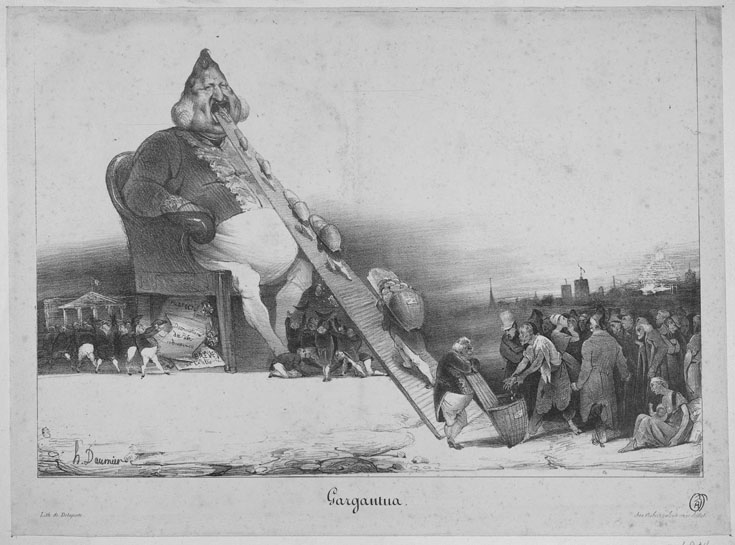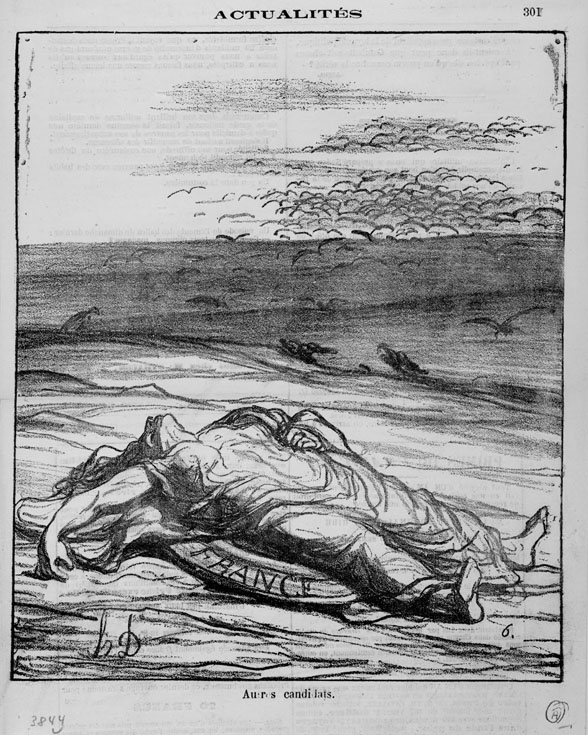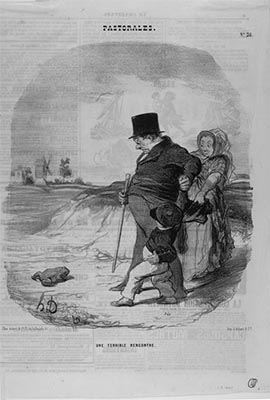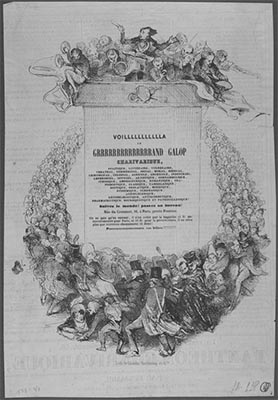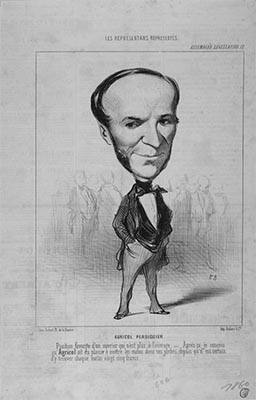Trustman Collection of Honoré Daumier Lithographs
December 1, 2015
Description by Max Close, undergraduate student in History and Archives & Special Collections assistant.
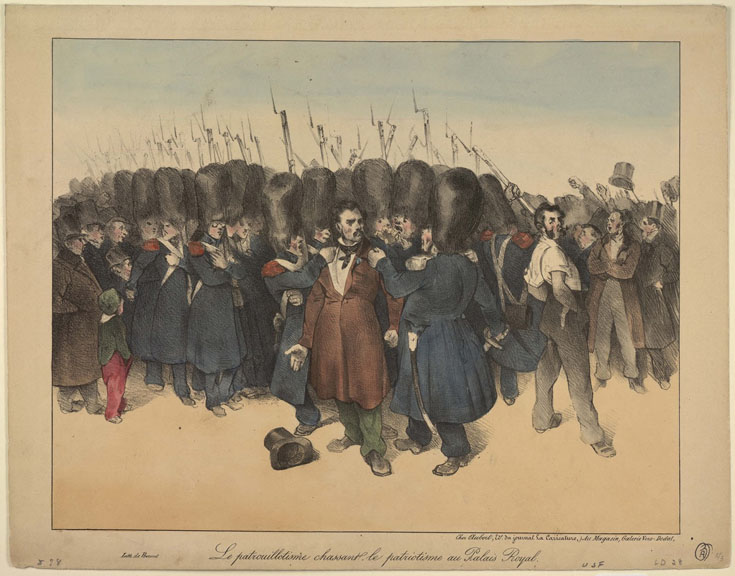 "Le Patriotisme," illustration in La Caricature
"Le Patriotisme," illustration in La Caricature
Though one can view Honoré Daumier’s 19th century lithographs from a purely artistic or purely political standpoint, they were often a blend of both. An artist whose work was characterized by whimsical and often surrealist imagery, Daumier (1808–1879) frequently made political statements with his art, but always sought to entertain. Brandeis is fortunate to count among its holdings the Benjamin A. and Julia M. Trustman Collection of Honoré Daumier Lithographs (finding aid here). While Daumier’s works (which, in addition to lithographs, include numerous paintings, drawings, sculptures and wood engravings) are found at institutions and museums across the globe, Brandeis’s Trustman Collection is one of the major Daumier collections in the United States. Comprising as it does nearly all (3,878) of the 4,000 known Daumier lithographs, and several proofs, illustrated books, and woodcuts, this collection is a unique resource for the study of both Honoré Daumier's art and nineteenth-century French history.[1]
Born in Marseilles in 1808, Daumier moved to Paris with his family in 1814, eventually becoming a part of and drawing inspiration from the cosmopolitan scene there. Daumier first used his talents in lithography on behalf of music publishers and advertisers at a young age (13 years old), before quickly expanding into political cartoons and other artistic endeavors. Early on in his career, Daumier received work and commissions from two magazines run by Charles Philipon known as La Caricature and then La Charivari.[2]
While Daumier's star has risen in the art world since his death, he was well known during his lifetime for his sometimes grotesque and other-worldly caricatures of French politicians and other fellow countrymen. In fact, he was once thrown in jail for a controversial cartoon entitled “Gargantua.”[3]
One example of his tongue-in-cheek portraiture is a lithograph depicting Agricol Perdiguier (1805–1875) — a French socialist politician and a Deputy after the 1848 revolution — who was forced into exile following the rise of Napoleon the Third in 1851. The caricature lampoons the salary of 25 francs the Deputy received, which was outrageous for the day.
Perhaps one of Daumier’s most moving and most scathing pieces is an 1871 work captioned (translated from the French) “Other Candidates,” wherein political candidates come in to scavenge on the carcass of a woman, labelled “France.” Such seriousness is present in many of Daumier’s drawings, paintings, and lithographs and exemplifies his more overtly political work.
Daumier did not, however, maintain a serious façade at all times, and there are examples of his lithographs being employed for less political ends.
Amongst his artwork lampooning French economy and politics, there are lithographs of polkas and poodles. One such piece, “Une Terrible Rencontre,” is a cartoon of an urban family encountering a frog on a walk in the country, the husband shielding his wife and child as though confronted by a monster. While not explicitly political, the image does gently rib the city dwellers of Paris for their increasing alienation from nature as the Industrial Revolution’s engines begin to turn. The simple image conveys a strong message about the strained relation between nature and the city dweller.
Alongside Daumier’s cartoons and caricatures stand some of the advertisements he created, including one for Le Charivari (a French illustrated magazine to which Daumier contributed), attempting to draw in new subscribers.;
The ad is not without Daumier’s token humor, as the title’s letters are repeated in caption, in all capitals, as though one is being shouted at through the image (“VOILLLLLLLLLA! GRRRRRRAND GALOP…”).
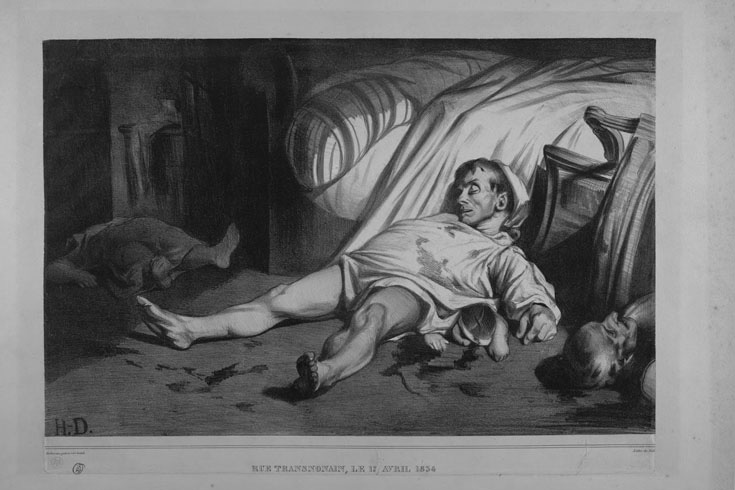 "Rue Transnonain, 15 de Avril 1834"
"Rue Transnonain, 15 de Avril 1834"
One of Daumier’s most famous prints is his “Rue Transnonain, 15 de Avril 1834,” depicting the aftermath of a bloody French National Guard attack on the French citizenry. The controversial lithograph stone was destroyed by the French government which also got rid of as many copies of the prints as possible. The only duplicates of this print were hidden from the state by Parisians and Brandeis has a copy of this rare piece.[4]
The value and appreciation of Daumier’s pieces rose after his death, with the École des Beaux-Arts holding an exhibition of his works in 1901. Today, Daumier has works in many prestigious museums, including the Louvre and the Metropolitan Museum of Art. Brandeis is proud to join these great museums in housing a fine collection of lithographs made by this acclaimed French artist.
High-quality digital images of the entire Trustman Collection are available through Brandeis Distinctive Collections.
Notes
- While the vast majority of these prints are from the large editions done on newsprint, there are also many fine examples printed on wove white paper (sur blanc).
- Wikipedia. “Honoré Daumier.” Last modified September 12, 2015.
- Artble. “Honoré Daumier.”
- Arts and Culture 104. “Rue Transnonain, Daumier.” Friday, December 10, 2010.
